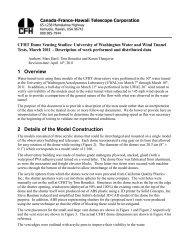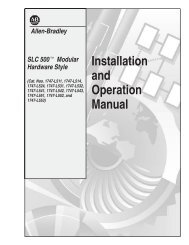Documentation [PDF] - Canada France Hawaii Telescope ...
Documentation [PDF] - Canada France Hawaii Telescope ...
Documentation [PDF] - Canada France Hawaii Telescope ...
You also want an ePaper? Increase the reach of your titles
YUMPU automatically turns print PDFs into web optimized ePapers that Google loves.
Wide Field Magnitude range u ∗ g r i z<br />
[MegaCam AB] [mag.] [mag.] [mag.] [mag.] [mag.]<br />
W1 [19.0 − 20.0] 0.013 0.007 0.009 0.010 0.025<br />
[20.0 − 21.0] 0.016 0.008 0.013 0.016 0.054<br />
[21.0 − 22.0] 0.024 0.014 0.023 0.031 0.112<br />
[22.0 − 23.0] 0.039 0.026 0.043 0.062 0.210<br />
[23.0 − 24.0] 0.065 0.046 0.078 0.114 0.359<br />
W2 [19.0 − 20.0] 0.010 0.006 0.010 0.009 0.020<br />
[20.0 − 21.0] 0.014 0.009 0.015 0.015 0.045<br />
[21.0 − 22.0] 0.024 0.016 0.025 0.030 0.100<br />
[22.0 − 23.0] 0.043 0.027 0.047 0.059 0.195<br />
[23.0 − 24.0] 0.074 0.044 0.083 0.108 0.344<br />
W3 [19.0 − 20.0] 0.011 0.007 0.009 0.010 0.023<br />
[20.0 − 21.0] 0.016 0.009 0.013 0.016 0.049<br />
[21.0 − 22.0] 0.025 0.014 0.022 0.033 0.101<br />
[22.0 − 23.0] 0.040 0.023 0.043 0.066 0.189<br />
[23.0 − 24.0] 0.062 0.036 0.079 0.123 0.324<br />
W4 [19.0 − 20.0] 0.008 0.006 0.008 0.010 0.019<br />
[20.0 − 21.0] 0.012 0.008 0.013 0.016 0.044<br />
[21.0 − 22.0] 0.023 0.013 0.024 0.031 0.097<br />
[22.0 − 23.0] 0.044 0.022 0.046 0.061 0.189<br />
[23.0 − 24.0] 0.079 0.036 0.083 0.111 0.332<br />
Table 10: Internal photometric errors per magnitude bins derived for each CFHTLS Wide field. The magnitudes of<br />
the objects detected in two stacks are compared. For each pair of stacks, a mean offset and dispersion is calculated<br />
from the magnitude differences of each pair of objects. Assuming a gaussian distribution of errors, the listed values<br />
are estimated as the dispersion divided by √ 2.<br />
are larger. This is to be expected and can be explained by several reasons: the statistics on the objects<br />
in the overlaps rely on sources detected at field edges where image quality and signal-to-noise is lowest<br />
due to dithering and PSF degradation at the edge of the field. Furthermore, the flatness of the photometry<br />
across the field of view show a departure from the reference central photometry on the very edges.<br />
This effect is slightly non-symmetric and affects the reliability of the magnitude measurements at the<br />
field edges. Therefore these error estimates should be considered as upper limits and contain residual<br />
systematic effects which add to the pure statistical flux measurement errors.<br />
4.4.3 Comparing CFHTLS-T0007 with SDSS-DR8<br />
As a further check of our reduction and calibration procedures we wish to compare photometric measurements<br />
on the CFHTLS Wide with an external and well-characterized survey. Our aim is to check<br />
both the relative tile-to-tile calibration and the absolute photometric calibration. At the present time, the<br />
best candidates are the surveys conducted using the Sloan telescope at Apache Point Observatory. The<br />
latest release of the main Sloan survey, SDSS-DR8, overlaps at least partially with all four Wide patches<br />
of the CFHTLS.<br />
50


![Documentation [PDF] - Canada France Hawaii Telescope ...](https://img.yumpu.com/26965302/62/500x640/documentation-pdf-canada-france-hawaii-telescope-.jpg)









